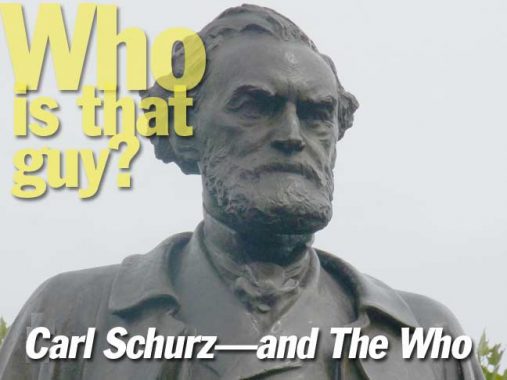West 116th Street comes to a temporary halt at a steep cliff marked by Morningside Park just east of Columbia University, and a sweeping view of upper Manhattan and beyond can be glimpsed from the top of this promontory. In 1913, the site was prepared for a monument to one of the premier immigrants the USA had taken in during the 19th Century, Carl Schurz (1829-1906).
Schurz, who by 1848 was a doctoral candidate at the University of Bonn, joined strenuous opposition to the Prussian government then in power. He wound up imprisoned but escaped to France, then England, and finally the USA in 1852. Among his many accomplishments here were his rise to a Civil War generalship, US Senator from Missouri (1869-1875), Rutherford Hayes’ Secretary of the Interior (1877-81), editor of the New York Tribune and Harper’s Weekly. Upon his death in 1906, this monument was commissioned by prominent lawyer Joseph Choate, who raised $93,000 for it.
Sculptor Karl Bitter and architect Henry Bacon collaborated on the monument, which consists of a sculpture of Schurz, three allegorical reliefs, a pair of granite exedra (benches) and a brick plaza. Bitter’s other best-known work is the goddess Pomona in the Grand Army Plaza fountain, while Bacon designed the Lincoln Memorial and NYC’s ubiquitous Type B park lamps.
The bas-reliefs are wild, mashups of Indian chiefs, Roman centurions, African natives, and robed citizens, apparently alluding to Schurz’s writings and concerns on world peoples. The Piccirilli Studios in the Bronx, the same firm that produced the US Capitol dome, executed the reliefs.
What do the beloved British rock group The Who have to do with Schurz? Nothing at all, but they did come to the monument in 1968 for a shoot with renowned photographer Art Kane, best known previously for his work with jazz musicians. The Who pretended to sleep with a Union Jack blanket, propped up against the left bronze relief for a 1968 Life Magazine series on rock musicians. When it first appeared the photo was unpopular with the conservative Life readership.
In 1979, Kane’s photo was re-used as the cover shot on the soundtrack to the documentary Who movie by Jeff Stein, The Kids Are Alright.
Not sure if the two decorative lamps on each side of the memorial still work. They are the only two surviving of the style in NYC.
Please help contribute to a new Forgotten NY website
Check out the ForgottenBook, take a look at the gift shop, and as always, “comment…as you see fit.”
8/16/18
